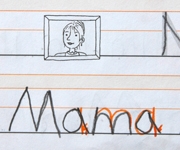 Learning to write: what’s in the way?
Learning to write: what’s in the way?
Accurate, endless repetition of a particular letter form is not particularly helpful when learning to write. When learning motor skills, there should be a much greater focus on a varied approach to discovering and experiencing individual solutions. Children should be able to try out new approaches in order to achieve their own good handwriting.

These factors have a negative effect on learning to write
1. Boundary lines: having to keep within the lines in the first phase of learning to write distracts children from fast, automated writing. Avoiding this is hugely important for developing fluid, efficient handwriting. Experienced writers carry out writing movements at a speed that their eyes can no longer monitor. Respecting boundary lines limits writing fluidity.
2. Slow and exaggerated controlled writing: the precise reproduction of letter forms and the conscious control of movements during writing are not helpful, even counterproductive. Directing the attention to a detail of the letter is sufficient to disturb automated execution considerably.
3. Not focussing on the writing process or the writing movements: if the focus is on the product of writing (the handwriting itself), incorrect writing movements cannot be recognised and rectified in good time.
4. Tracing exercises and slow-motion precision handwriting: exact tracing prevents rhythmically written forms being committed to memory.
5. The exact joining of letters and zero tolerance: precisely hitting the contact points in letters represents a visual and motor challenge that hugely slows down writing flow.
6. Incorrect sitting posture: an irregular forward-leaning sitting posture, supported by the writing arm, hinders the movements of the writing hand.
7. Incorrect hand posture: a very crooked, immobile wrist hinders the movements of the writing hand.
8. Inefficient pen hold: irregular finger positions (e.g. rigidly bent fingers) lead to pressure pain, increasing cramp and ungainly handwriting.
9. Left-handedness going unrecognised.
Further reading
MAI N.; MARQUARDT C.; QUENZEL I.: Wie kann die Flüssigkeit von Schreibbewegungen gefördert werden? In: Balhorn H, Niemann H (Hrsg.) Sprachen werden Schrift. Lengwil, Schweiz: Libelle, 1997.
The complete publications by the Schreibmotorik Institut
If you want to use information or contents of this article, please cite it as follows:
Schreibmotorik Institut e.V. (2017). Learning to write: What’s in the way? Retrieved [Month dd, yyyy] from http://www.schreibmotorik-institut.com/index.php/en/facts-tips/expertise/513-learning-to-write-what-s-in-the-way

